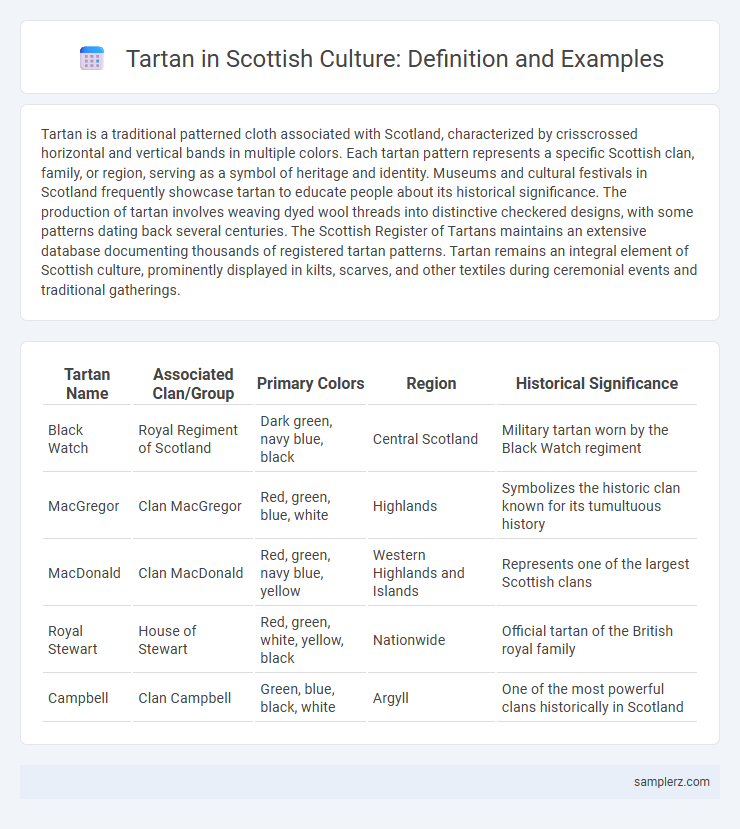Tartan is a traditional patterned cloth associated with Scotland, characterized by crisscrossed horizontal and vertical bands in multiple colors. Each tartan pattern represents a specific Scottish clan, family, or region, serving as a symbol of heritage and identity. Museums and cultural festivals in Scotland frequently showcase tartan to educate people about its historical significance. The production of tartan involves weaving dyed wool threads into distinctive checkered designs, with some patterns dating back several centuries. The Scottish Register of Tartans maintains an extensive database documenting thousands of registered tartan patterns. Tartan remains an integral element of Scottish culture, prominently displayed in kilts, scarves, and other textiles during ceremonial events and traditional gatherings.
Table of Comparison
| Tartan Name | Associated Clan/Group | Primary Colors | Region | Historical Significance |
|---|---|---|---|---|
| Black Watch | Royal Regiment of Scotland | Dark green, navy blue, black | Central Scotland | Military tartan worn by the Black Watch regiment |
| MacGregor | Clan MacGregor | Red, green, blue, white | Highlands | Symbolizes the historic clan known for its tumultuous history |
| MacDonald | Clan MacDonald | Red, green, navy blue, yellow | Western Highlands and Islands | Represents one of the largest Scottish clans |
| Royal Stewart | House of Stewart | Red, green, white, yellow, black | Nationwide | Official tartan of the British royal family |
| Campbell | Clan Campbell | Green, blue, black, white | Argyll | One of the most powerful clans historically in Scotland |
Historical Origins of Tartan in Scotland
Tartan patterns in Scotland trace back to the early medieval period, originally serving as distinctive woolen cloth designs identifying different clans and regions. Archaeological evidence and historical records from the 16th century highlight tartan's role in Scottish identity and social structure. The Battle of Culloden in 1746 further cemented tartan as a symbol of Scottish heritage amid cultural suppression.
Cultural Significance of Scottish Tartans
Scottish tartans symbolize clan identity and regional heritage, with distinct patterns representing specific families and historical affiliations. These woven wool designs carry deep cultural significance, embodying pride, lineage, and the enduring traditions of Scotland. Wearing tartan in ceremonies and festivals reinforces community bonds and preserves a unique aspect of Scottish history.
Iconic Clans and Their Distinct Tartans
Scotland's iconic clans each boast distinct tartans that symbolize their unique heritage and identity, such as the Royal Stewart, MacGregor, and Campbell patterns. These tartans serve as powerful cultural emblems, woven through centuries of tradition and clan history. The intricate designs and specific color schemes are registered officially, preserving clan legacies and reinforcing Scottish cultural pride.
Tartan in Traditional Scottish Dress
Tartan is a distinctive woolen fabric pattern featuring crisscrossed horizontal and vertical bands in multiple colors, intrinsically linked to Scotland's cultural heritage. Each Scottish clan possesses unique tartan designs used in traditional dress such as kilts, representing family identity and regional pride. Tartan patterns have historical significance dating back centuries, symbolizing unity and continuity within Scottish communities.
Modern Uses of Tartan in Scotland
Modern uses of tartan in Scotland extend beyond traditional kilts to fashion, home decor, and corporate branding, reflecting a blend of heritage and contemporary style. Designers incorporate tartan patterns in everyday clothing such as scarves, jackets, and accessories, fostering cultural identity while appealing to global trends. Scottish festivals and events showcase tartan as a symbol of regional pride, inspiring innovative adaptations in textiles and digital media.
Tartan Patterns and Their Meanings
Tartan patterns in Scotland symbolize clan heritage and regional identity through distinctive color combinations and designs. Each tartan's unique arrangement of stripes and hues represents various Scottish families or associations, reflecting historical lineage and cultural pride. Wearing a specific tartan connects individuals to their ancestry and traditional Scottish customs, preserving cultural continuity.
Tartan’s Role in Scottish Festivals and Events
Tartan serves as a powerful symbol of Scottish heritage, prominently displayed during festivals such as the Highland Games and Burns Night celebrations. Each clan's unique tartan pattern fosters a strong sense of identity and community pride, reinforcing historical connections through wear and display. These vibrant textiles enliven events, promoting cultural continuity and attracting global visitors to Scotland's traditional gatherings.
Legal Protection and Registration of Tartans
Scotland enforces legal protection and registration of tartans through the Scottish Register of Tartans, which maintains a comprehensive database of officially recognized patterns to preserve cultural heritage. The registration process ensures unique design authenticity, preventing unauthorized commercial exploitation and misuse of tartan patterns. Intellectual property rights associated with tartans support traditional clans, designers, and manufacturers, reinforcing Scotland's commitment to safeguarding its iconic cultural symbol.
Influence of Tartan on Scottish Identity
Tartan patterns in Scotland serve as powerful symbols of clan heritage and regional identity, deeply embedded in Scottish culture and history. Each unique design represents familial lineage and local pride, reinforcing community bonds and a collective sense of belonging. The widespread use of tartan in ceremonies, festivals, and national dress underscores its enduring influence on Scottish identity and cultural expression.
Global Spread and Adaptation of Scottish Tartan
Scottish tartan, originally a symbol of Highland clans, has achieved global recognition and adaptation through fashion, military uniforms, and cultural events worldwide. International designers have incorporated tartan patterns into mainstream apparel, while diaspora communities promote traditional Scottish heritage at festivals and national celebrations. The widespread use of tartan underscores its evolution from a regional textile to a global cultural emblem symbolizing identity and heritage.

example of "tartan" in "Scotland Infographic
 samplerz.com
samplerz.com